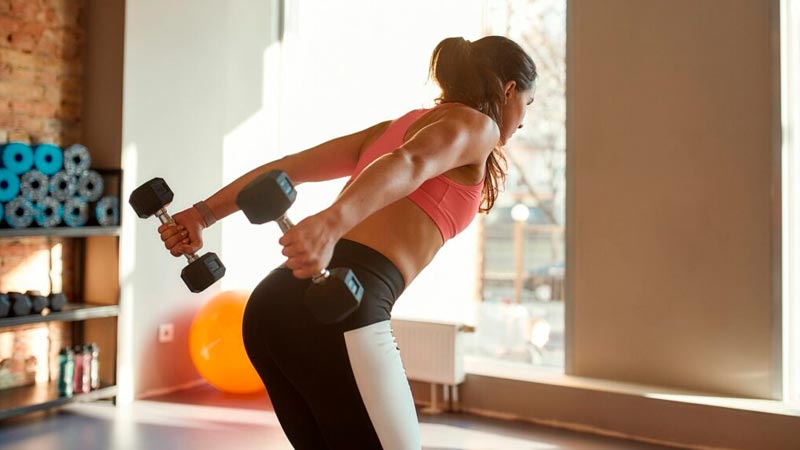Dumbbell tricep exercises are an effective way to strengthen and tone the muscles in the back of the arm. These exercises can be done at home or in the gym with a set of dumbbells, making them a convenient option for those who want to work out without leaving their house.
Table of Contents
By incorporating dumbbell tricep exercises into their routine, individuals can improve their overall fitness and achieve their fitness goals.
One of the most popular dumbbell tricep exercises is the tricep extension. This exercise involves holding a dumbbell with both hands and lifting it above the head, then lowering it behind the head. This movement targets the tricep muscles and can be done with a variety of weights to increase or decrease the intensity of the exercise.
Another effective dumbbell tricep exercise is the kickback, which involves holding a dumbbell in one hand and extending the arm behind the body, focusing on contracting the tricep muscle. These exercises can be done individually or as part of a larger workout routine to help individuals achieve their desired results.
Tricep Anatomy
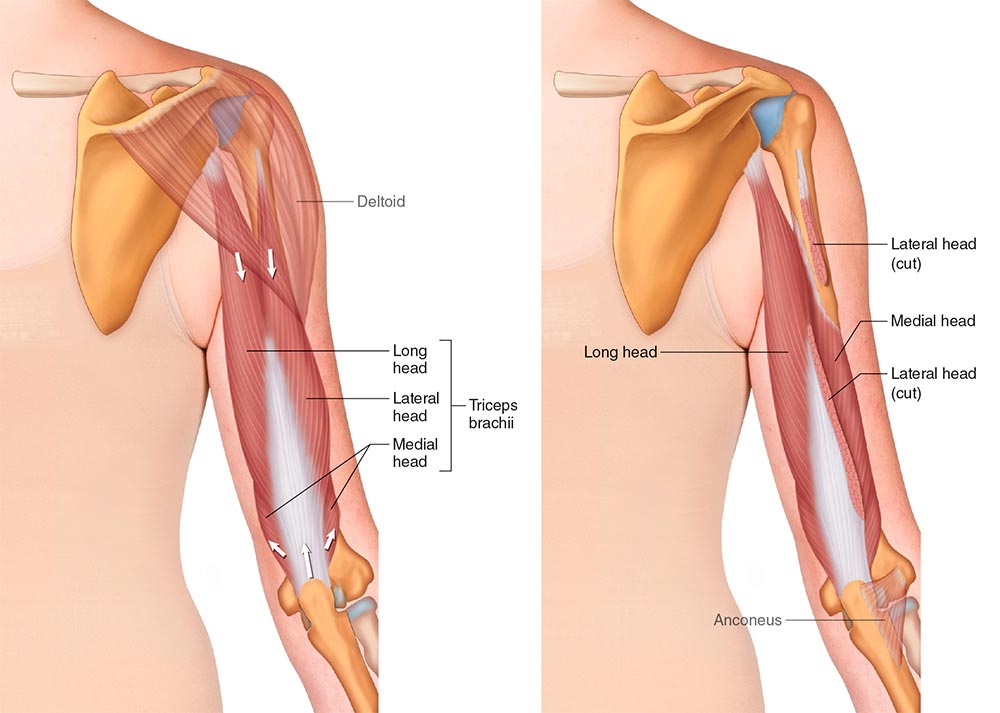
The triceps brachii muscle, commonly referred to as the triceps, is a three-headed muscle located on the back of the upper arm. It is responsible for extending the elbow joint and plays a crucial role in various upper body movements such as pushing and pulling.
The three heads of the triceps muscle are the long head, lateral head, and medial head. Each head originates from a different point on the humerus bone and inserts into the ulna bone of the forearm. The long head runs along the back of the arm and is the largest of the three heads. The lateral head is located on the outer side of the arm, while the medial head is on the inner side of the arm.
Understanding the anatomy of the triceps is essential for selecting the right exercises to target each head of the muscle. For example, exercises that involve overhead arm movements primarily target the long head, while exercises that involve arm extensions with elbows close to the body primarily target the lateral and medial heads.
In addition to the triceps muscle, the brachialis and brachioradialis muscles also contribute to elbow extension. However, these muscles are smaller and less significant than the triceps.
Importance of Dumbbell Tricep Exercises
Dumbbell tricep exercises are an essential part of any strength training routine. The triceps are the muscles located at the back of the upper arm, and they play a crucial role in many everyday activities, such as pushing, pulling, and lifting. Strong triceps also improve overall arm strength and can help prevent injury.
Dumbbell tricep exercises are particularly effective because they allow for a greater range of motion and more targeted muscle activation than other tricep exercises. Additionally, dumbbells are easy to use and can be adjusted to suit individual strength levels.
Regularly incorporating dumbbell tricep exercises into a workout routine can lead to significant improvements in tricep strength and overall upper body strength. These exercises can also help to improve muscle definition and tone, which can enhance the appearance of the arms.
Some popular dumbbell tricep exercises include overhead tricep extensions, tricep kickbacks, and skull crushers. It is important to use proper form and start with a weight that is appropriate for your strength level to avoid injury.
Overall, incorporating dumbbell tricep exercises into a strength training routine is a simple and effective way to improve tricep strength and overall upper body strength.
Safety Precautions
When performing dumbbell tricep exercises, it is important to take certain safety precautions to avoid injury. Here are a few safety tips to keep in mind:
Start with a Warm-Up
Before beginning any tricep exercises, it is essential to warm up the muscles. This can be done through light cardio exercises such as jumping jacks or jogging in place. Additionally, stretching the tricep muscles can help prevent injury and improve flexibility.
Use Proper Form
When performing dumbbell tricep exercises, it is crucial to use proper form to avoid injury and maximize the effectiveness of the exercise. This includes keeping the elbows close to the body and maintaining a neutral wrist position. It is also important to avoid swinging the weights or using momentum to lift them.
Choose the Right Weight
Selecting the appropriate weight for dumbbell tricep exercises is important to prevent injury and ensure proper form. It is recommended to start with a lighter weight and gradually increase as strength improves. Using weights that are too heavy can lead to muscle strain or other injuries.
Take Breaks
It is important to take breaks between sets of dumbbell tricep exercises to allow the muscles to rest and recover. Additionally, taking breaks can help prevent fatigue and reduce the risk of injury.
Listen to Your Body
Finally, it is important to listen to your body when performing dumbbell tricep exercises. If you experience pain or discomfort, stop the exercise immediately and seek medical attention if necessary. Pushing through pain can lead to further injury and delay recovery time.
Dumbbell Tricep Exercises
The triceps brachii, commonly known as triceps, are a group of muscles located in the back of the upper arm. Strengthening these muscles is essential for improving arm strength and definition. One of the most effective ways to work out the triceps is through dumbbell exercises.
Here are five dumbbell tricep exercises to consider adding to your workout routine.
1. Standing Dumbbell Tricep Extension
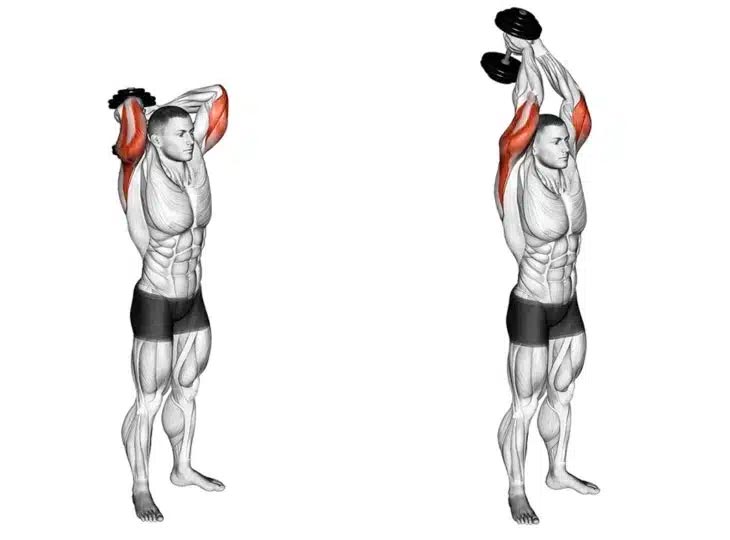
The standing dumbbell tricep extension is a great exercise for targeting the long head of the triceps. Here's how to perform it:
- Stand with your feet shoulder-width apart and hold a dumbbell in both hands.
- Raise the dumbbell above your head, keeping your elbows close to your ears.
- Slowly lower the dumbbell behind your head, bending your elbows.
- Pause for a second, then slowly raise the dumbbell back to the starting position.
2. Dumbbell Kickback
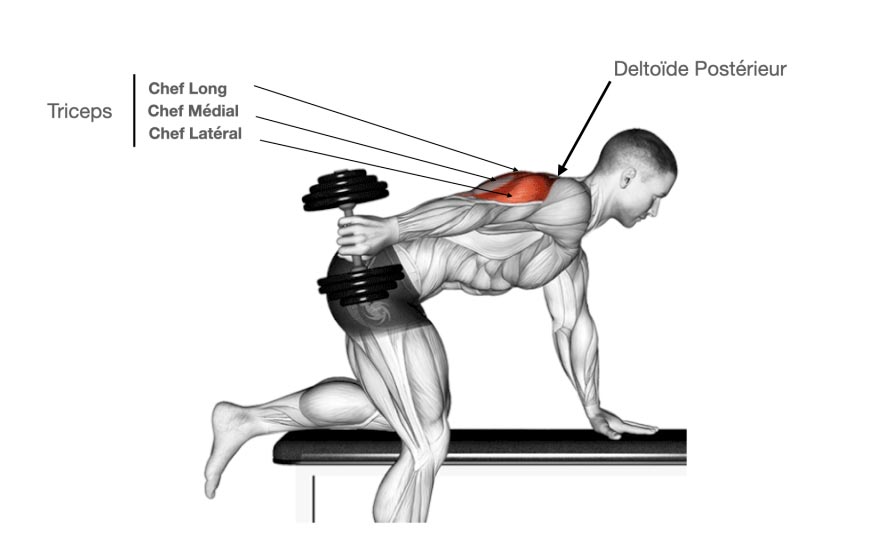
The dumbbell kickback is another effective exercise for targeting the triceps. Here's how to perform it:
- Hold a dumbbell in your right hand and place your left hand and left knee on a bench.
- Keep your back straight and your right arm close to your body.
- Slowly extend your right arm behind you, keeping your elbow close to your body.
- Pause for a second, then slowly lower the dumbbell back to the starting position.
- Repeat for the desired number of reps, then switch sides.
3. Overhead Dumbbell Tricep Extension
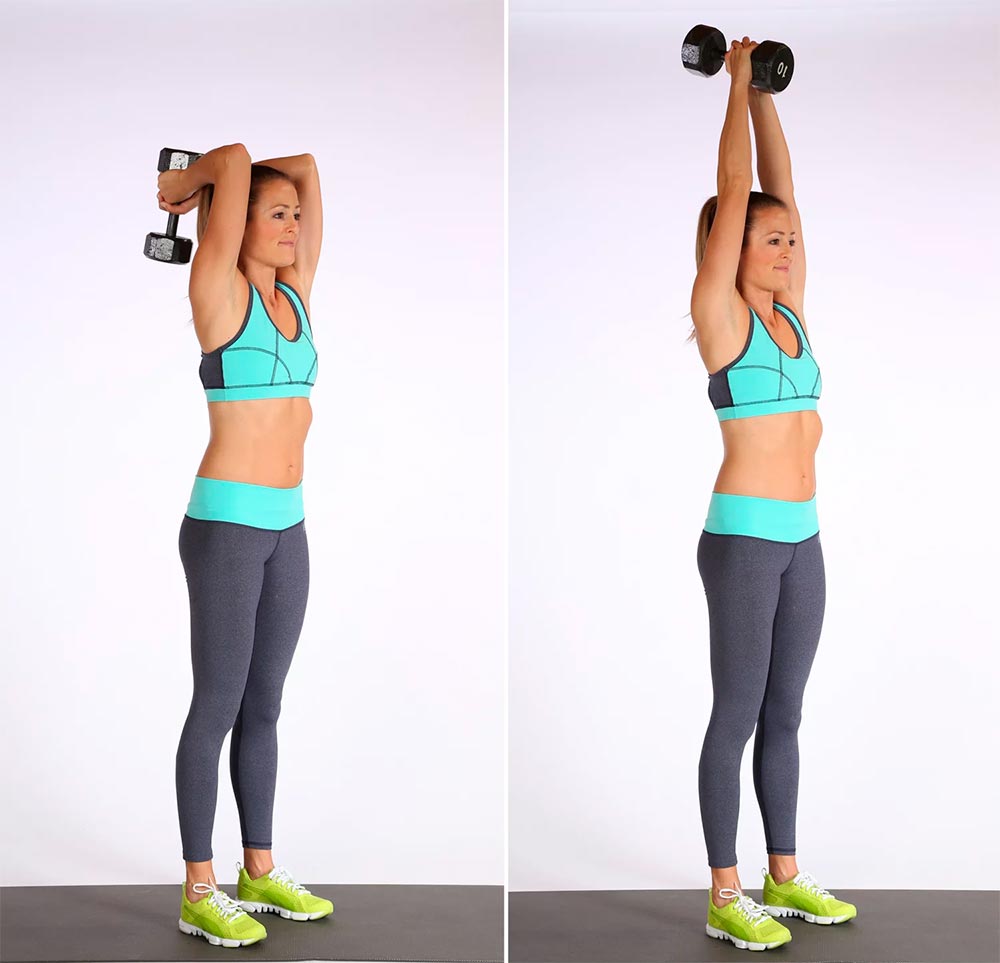
The overhead dumbbell tricep extension is a challenging exercise that targets all three heads of the triceps. Here's how to perform it:
- Stand with your feet shoulder-width apart and hold a dumbbell in both hands.
- Raise the dumbbell above your head, keeping your elbows close to your ears.
- Slowly lower the dumbbell behind your head, bending your elbows.
- Pause for a second, then slowly raise the dumbbell back to the starting position.
4. Dumbbell Tricep Press
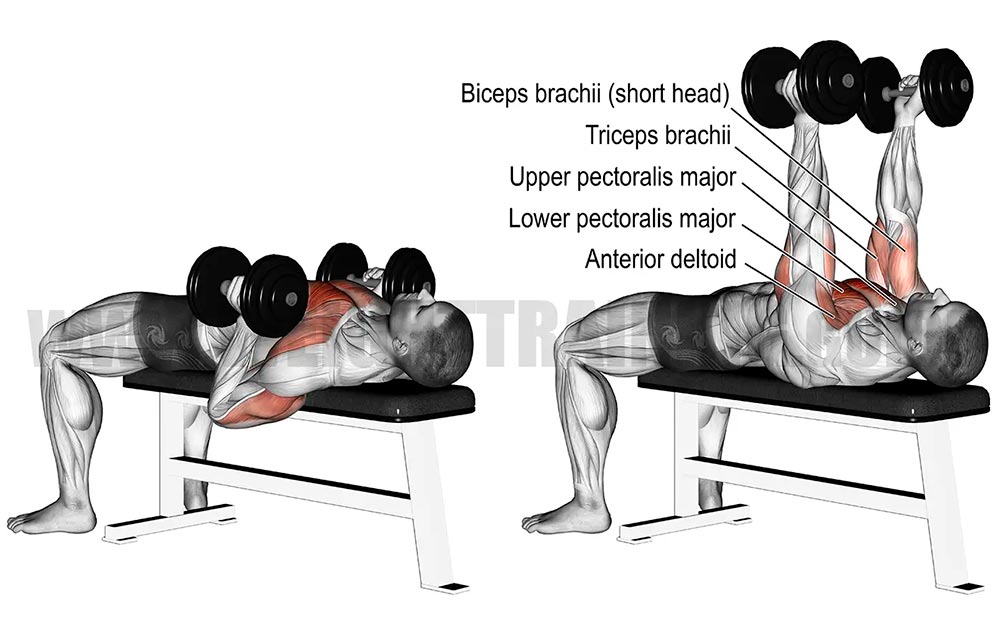
The dumbbell tricep press is a great exercise for targeting the triceps as well as the chest and shoulders. Here's how to perform it:
- Lie on a bench with a dumbbell in each hand.
- Hold the dumbbells above your chest with your palms facing each other.
- Slowly lower the dumbbells to your chest, bending your elbows.
- Pause for a second, then slowly press the dumbbells back up to the starting position.
5. Seated Dumbbell Tricep Extension
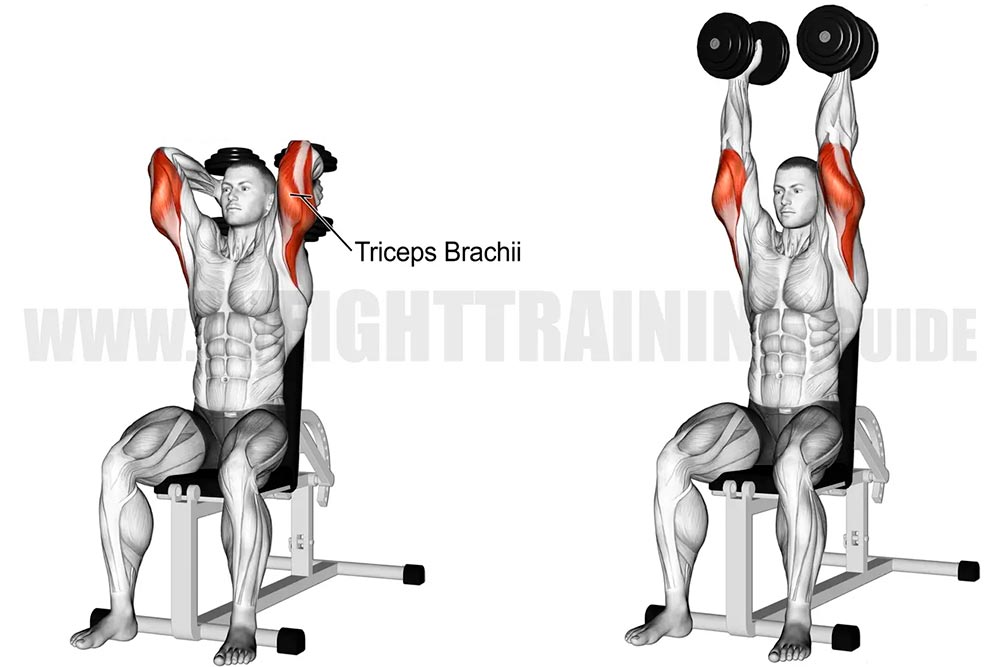
The seated dumbbell tricep extension is a great exercise for targeting the triceps while seated. Here's how to perform it:
- Sit on a bench with a dumbbell in each hand.
- Raise the dumbbells above your head, keeping your elbows close to your ears.
- Slowly lower the dumbbells behind your head, bending your elbows.
- Pause for a second, then slowly raise the dumbbells back to the starting position.
Incorporating these dumbbell tricep exercises into your workout routine can help you achieve stronger, more defined triceps. Remember to start with a weight that is comfortable for you and gradually increase it as your strength improves.
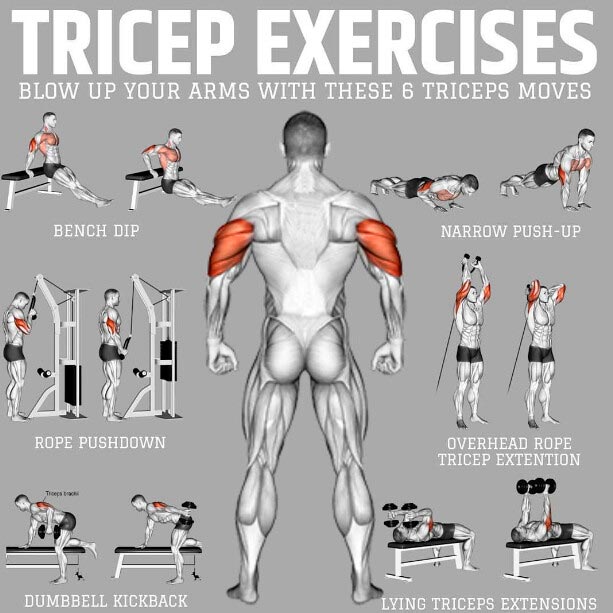
Videos of Dumbbell Tricep Exercise
Exercise Progression
When it comes to tricep exercises with dumbbells, there are various ways to progress and challenge oneself. Here are a few ways to progress and increase the difficulty of the exercises:
-
Increase the weight: As one gets stronger, increasing the weight of the dumbbells can help to challenge the triceps even more.
-
Increase the number of reps: Adding more reps to each set can help to increase endurance and overall strength.
-
Increase the number of sets: Increasing the number of sets can help to increase the overall volume of the workout, leading to greater muscle growth.
-
Change the exercise variation: Switching up the exercise variation can help to challenge the triceps in different ways, leading to greater overall strength and muscle development.
-
Incorporate supersets: Supersets involve performing two exercises back-to-back with little to no rest in between. Incorporating supersets can help to increase the overall intensity of the workout and challenge the triceps even more.
-
Use tempo training: Tempo training involves slowing down the movement of the exercise, which can help to increase time under tension and challenge the triceps in a different way.
By incorporating these progression techniques, one can continue to challenge their triceps and see continued progress in their strength and muscle development.
Common Mistakes and How to Avoid Them
When it comes to dumbbell tricep exercises, there are a few common mistakes that people make. These mistakes can not only hinder your progress but also lead to injury. In this section, we will discuss the most common mistakes and how to avoid them.
Using Too Much Weight
One of the most common mistakes people make when performing dumbbell tricep exercises is using too much weight. Using too much weight can lead to poor form, which can cause injury. It's important to start with a weight that is comfortable and allows you to perform the exercise with proper form. As you get stronger, you can gradually increase the weight.
Not Using Full Range of Motion
Another mistake people make is not using the full range of motion when performing dumbbell tricep exercises. Not using the full range of motion can limit the effectiveness of the exercise. Make sure to extend your arms fully and bring the dumbbells all the way down to your shoulders.
Flaring Elbows Outward
Flaring your elbows outward is another common mistake people make when performing dumbbell tricep exercises. This can cause unnecessary strain on your shoulders and decrease the effectiveness of the exercise. Keep your elbows close to your body throughout the exercise.
Not Engaging Core Muscles
Finally, not engaging your core muscles is another mistake people make when performing dumbbell tricep exercises. Engaging your core muscles can help stabilize your body and prevent injury. Make sure to keep your core tight throughout the exercise.
By avoiding these common mistakes, you can ensure that you are getting the most out of your dumbbell tricep exercises while minimizing the risk of injury.
Benefits of Dumbbell Tricep Exercises
Dumbbell tricep exercises are a great way to target the triceps muscles, which are located on the back of the upper arms. These muscles are responsible for extending the elbow joint and are essential for many daily activities such as pushing, pulling, and lifting.
Here are some of the benefits of incorporating dumbbell tricep exercises into your workout routine:
-
Increased Muscle Strength: Dumbbell tricep exercises are an effective way to increase muscle strength in the triceps. By gradually increasing the weight of the dumbbells, you can challenge your muscles and promote growth.
-
Improved Muscle Definition: Dumbbell tricep exercises can also help to improve muscle definition in the triceps. As the muscles grow and become stronger, they will become more visible under the skin.
-
Reduced Risk of Injury: Strong triceps can help to reduce the risk of injury in the shoulders and elbows. By strengthening the triceps, you can help to stabilize these joints during exercise and daily activities.
-
Increased Metabolism: Dumbbell tricep exercises can also help to increase your metabolism. As you build muscle, your body will burn more calories at rest, which can help to promote weight loss and improve overall health.
Overall, incorporating dumbbell tricep exercises into your workout routine can help to improve muscle strength, definition, and reduce the risk of injury.
Frequently Asked Questions
When it comes to tricep exercises, people often have questions about the right technique, the best weights to use, and how often to do them. Here are some frequently asked questions about dumbbell tricep exercises:
What are the benefits of dumbbell tricep exercises?
Dumbbell tricep exercises are a great way to strengthen and tone your triceps. They also help to improve your overall upper body strength and stability. By working your triceps, you can improve your performance in other exercises such as bench press, push-ups, and dips. Additionally, strong triceps can help to prevent injuries and improve your posture.
How heavy should the dumbbells be for tricep exercises?
The weight of the dumbbells you use for tricep exercises will depend on your fitness level and experience. Beginners should start with lighter weights, such as 5-10 pounds, while more advanced lifters can use heavier weights, such as 15-20 pounds or more. It's important to choose a weight that allows you to perform the exercise with proper form and technique.
How often should you do dumbbell tricep exercises?
The frequency of your tricep workouts will depend on your fitness goals and overall workout routine. In general, it's recommended to train your triceps 1-2 times per week, with at least 48 hours of rest between workouts. Overtraining your triceps can lead to injury and slow down your progress, so it's important to give your muscles time to recover.
What are some common mistakes to avoid when doing dumbbell tricep exercises?
Some common mistakes to avoid when doing dumbbell tricep exercises include:
- Using too much weight and sacrificing proper form
- Allowing your elbows to flare out during exercises like tricep extensions
- Not fully extending your arms during exercises like skull crushers
- Not keeping your core engaged and your back straight during exercises like overhead tricep extensions
By focusing on proper form and technique, you can maximize the benefits of your tricep workouts and avoid injury.
Conclusion
Dumbbell tricep exercises are an effective way to build strength and muscle in the triceps. Incorporating a variety of exercises into your workout routine can help prevent plateaus and ensure continued progress.
It is important to use proper form and technique when performing these exercises to avoid injury and maximize results. Gradually increasing weight and reps over time can also help challenge the muscles and promote growth.
Some of the most effective dumbbell tricep exercises include the overhead tricep extension, lying tricep extension, and tricep kickback. These exercises target different areas of the triceps and can be performed using a variety of grips and angles.
Overall, incorporating dumbbell tricep exercises into your workout routine can help improve overall arm strength and muscle definition. By using proper form and gradually increasing weight and reps, individuals can see significant improvements in their tricep strength and appearance.
Stay healthy!
